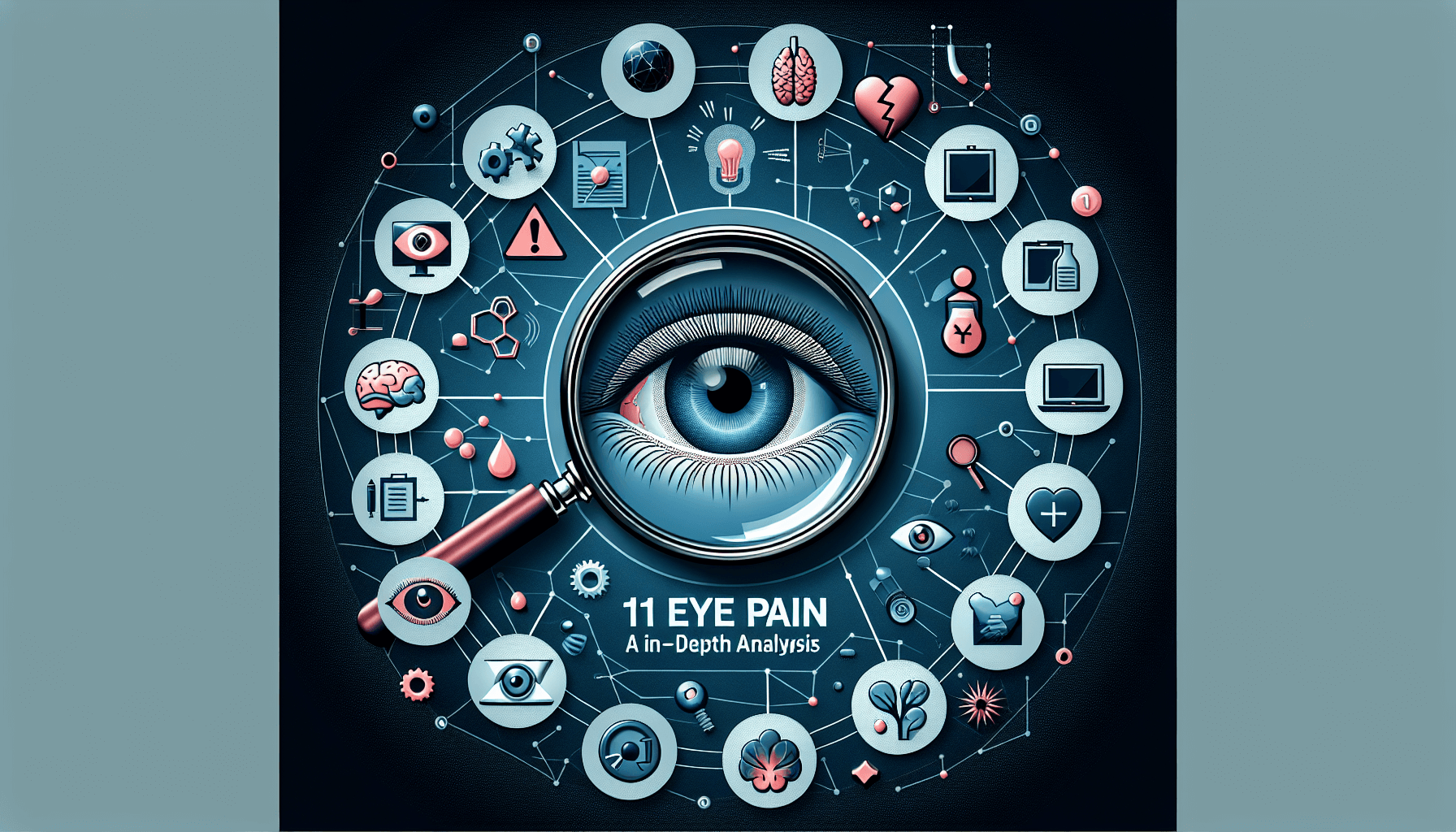
Table of Contents
Eye pain, a problem that can emerge from various causes like infections, inflammation, and dry eye to more severe conditions such as acute glaucoma and sinus problems, affects a large number of people. The discomfort may manifest as sharp, throbbing, or aching sensations in one or both eyes, extending beyond simple irritation to include more intense and prolonged experiences[1][2]. This condition not only impacts the eye itself, involving different parts such as the eyelid, conjunctiva, and cornea, but it can also lead to symptoms like swelling, pressure, and the feeling of something being in the eye, which signals the need for immediate medical attention in severe cases[2].
With common contributors to eye pain including contact lens complications, allergies, toxins, and increased eye pressure, it’s essential to understand when to consult a doctor or pursue tests for conditions like conjunctivitis, sinusitis, glaucoma, pink eye, and fungal infections[2]. Additionally, practical advice like resting the eyes or switching from contacts to glasses temporarily may offer relief for some[1]. This article delves into the underlying reasons for eye pain, offering an in-depth analysis that not only outlines the possible causes and associated symptoms but also guides on navigating diagnosis processes, treatments, and preventative measures against such discomforts.
Understanding the Common Causes of Eye Pain
Eye pain, a multifaceted symptom with a range of causes, can significantly impact one’s quality of life. The origins of this discomfort can be broadly categorized into infections, mechanical issues, and environmental factors.
- Infections and Inflammation: Conditions such as conjunctivitis (commonly known as pink eye), corneal infections, uveitis, and optic neuritis are prime examples where infection or inflammation leads to eye pain. These conditions often present with additional symptoms like redness, discharge, and visual disturbance.
- Mechanical Causes and Allergies: The use of contact lenses, especially if improperly cleaned or worn for extended periods, can lead to corneal abrasions or infections. Allergies, too, play a significant role, with seasonal changes triggering symptoms in susceptible individuals. Eyelid issues such as blepharitis, chalazion, or stye contribute to discomfort by causing inflammation around the eye.
- Environmental Factors and Other Causes: Exposure to toxins, increased eye pressure from glaucoma, and even sinusitis can manifest as eye pain. Dry eyes, a common condition in today’s screen-heavy lifestyle, also lead to a persistent sense of discomfort.
Understanding these common causes is crucial for identifying the underlying issue and seeking appropriate treatment.
When to Seek Immediate Medical Attention
Recognizing when to seek immediate medical attention for eye pain is essential for preventing further complications. Here are critical scenarios necessitating prompt action:
- Ophthalmologic Emergencies:
- Acute angle-closure glaucoma, optic neuritis, orbital cellulitis, scleritis, anterior uveitis, infectious keratitis demand immediate ophthalmology consultation.
- Injury and Trauma:
- Eye injuries require urgent care. Protect the eye with a shield and refrain from rinsing or removing objects.
- Symptoms like severe pain, trauma-induced discomfort, light sensitivity with blurry vision, and redness are red flags.
- Experiencing burning, itching, double vision, headaches with visual symptoms, or rapid swelling necessitates a visit to an optometrist.
- Symptoms Warranting Immediate Attention:
- Persistent symptoms over a week, changes in vision, eye pain with light sensitivity, or discharge.
- Unusual severity, headache, fever, sensitivity to light, or if experiencing a foreign object or chemical in the eye, difficulty moving the eye, blood or pus discharge, or uncontrollable bleeding.
Immediate consultation with an eye care professional is crucial for these conditions to mitigate risks and ensure the health of your eyes.
Diagnosis Process for Eye Pain
When diagnosing the cause of eye pain, healthcare providers embark on a meticulous process that begins with a comprehensive review of the patient’s medical history and symptoms, followed by a thorough eye examination. This initial step is crucial in identifying any underlying conditions that could be contributing to the discomfort.
Key Diagnostic Tools and Procedures:
- Slit-lamp Examination: Utilizes a high-intensity light source to examine the structures of the eye in detail.
- Dilating Drops: Applied to widen the pupil, allowing for a closer inspection of the eye’s internal structures.
- Tonometer: Measures the eye’s pressure, an essential test for diagnosing glaucoma.
- Fluorescein Staining: Helps detect corneal abrasions, ulcers, or infections by highlighting areas of damage.
- Visual Acuity Test: Assesses how well the patient can see at various distances.
The diagnosis process aims to identify conditions such as Conjunctivitis, Corneal Abrasions, Glaucoma, and Sinusitis, among others. To further support the diagnosis, patients may be asked to quantify their pain using scales and validated survey instruments like the OPAS, which specifically measures ocular pain. This comprehensive approach not only aids in pinpointing the exact cause of eye pain but also in determining whether the pain is peripherally mediated or has become centralized, which is crucial for devising an effective treatment plan.
Possible Treatments for Various Eye Pain Causes
Addressing eye pain effectively hinges on pinpointing its root cause, which can range from infections and inflammations to mechanical issues and environmental factors. Here’s a breakdown of treatments based on common eye pain causes:
- Infections and Inflammations:
- Conjunctivitis: Utilize antiviral, antibacterial, or anti-allergy medications depending on the cause.
- Blepharitis: Emphasize eyelid hygiene, apply warm compresses, and use antibiotics if necessary.
- Optic Neuritis: Treat with systemic corticosteroids to reduce inflammation and hasten recovery.
- Mechanical Causes and Allergies:
- Dry Eyes: Implement artificial tears and identify and avoid triggers.
- Allergies: Pinpoint and steer clear of allergens; consider OTC antihistamines and prescription medications.
- Styes/Chalazia: Apply warm compresses; antibiotics or surgical removal may be warranted in some cases.
- Other Causes:
- Glaucoma: Employ medications and possibly surgery to mitigate further damage.
- Cluster Headaches: Explore pain treatments such as sumatriptan injections, nasal sprays, and oxygen therapy.
For physiological pain stemming from tissue damage, the focus is on treating the underlying cause or inflammation. In contrast, neuropathic pain, which results from damage to nociceptors or associated structures, might necessitate systemic or psychological interventions. This comprehensive approach ensures that treatment is tailored not only to alleviate symptoms but also to address the underlying health issue, promoting long-term eye health and comfort.
Prevention Tips to Avoid Eye Pain
Preventing eye pain involves a combination of home remedies, environmental adjustments, and proper eye care practices. Here are actionable tips to help safeguard your eyes against discomfort:
Home Remedies and Environmental Adjustments:
- Adjust the Lighting: For TV viewing, keep the room softly lit. Use a light source behind you for reading or close work.
- Take Breaks: During prolonged reading or screen time, rest your eyes periodically.
- Limit Screen Time: Essential for children to prevent eyestrain.
- Use Artificial Tears: Prevent dry eyes by using nonprescription artificial tears regularly.
- Improve Air Quality: Use a humidifier, adjust the thermostat, and avoid smoke to reduce dry air exposure.
Proper Eyewear and Screen Adjustments:
- Choose Correct Eyewear: Invest in glasses or contacts designed for computer work if needed.
- Adjust Your Monitor: Ensure it’s an arm’s length away, with the top at or just below eye level.
- Blink Often: Helps refresh your eyes, especially important during computer work.
Regular Eye Care:
- Eye Check-ups: Detect underlying issues early.
- Protective Eyewear: Use during risky activities.
- Contact Lens Care: Follow hygiene practices to avoid overwearing.
- Manage Allergies: Use medication and avoid allergens.
- Avoid Toxins: Steer clear of cigarette smoke and chlorine.
- Eye Rest: Regularly rest your eyes, particularly after screen use.
Incorporating these strategies can significantly reduce the risk of eye pain, ensuring long-term eye health and comfort.
Conclusion
Through an in-depth exploration of the common reasons for eye pain, this article unequivocally underscores the complexity and array of potential triggers, from infections and inflammation to environmental factors and damage. The imperative to recognize symptoms early and seek appropriate medical attention cannot be overstated, as eye pain can serve as a harbinger of more severe conditions. The discussion has not only illuminated the various causes and diagnoses processes but has also provided invaluable insights into effective treatments and preventative measures to uphold ocular health.
The significance of understanding and addressing eye pain lies not just in alleviating immediate discomfort but in preempting long-term damage to eye health. As we’ve seen, interventions range from simple home remedies to complex medical treatments depending on the cause. The article unequivocally propels readers towards a more informed and proactive stance on eye care, emphasizing the importance of regular check-ups, protective measures, and an adjusted lifestyle to mitigate risks. It leaves us with a clear message: taking comprehensive care of our eyes is imperative for overall well-being.
FAQs
What are some common causes of eye pain?
Eye pain can be attributed to a variety of factors, including infections, inflammation, issues with contact lenses, dry eye syndrome, acute glaucoma, sinus complications, neuropathy, and eyestrain.
When should I be concerned about eye pain?
It’s important to seek medical attention if you experience severe pain, any loss of vision, significant discomfort or reduced vision when using contact lenses, or if you have sustained trauma, chemical injury, or have had recent eye surgery. These are considered red flags for referral to a specialist.
Why might I experience a sharp, stabbing sensation in my eye?
A sharp, stabbing pain in the eye can be caused by several conditions, including foreign objects in the eye or glaucoma. Left untreated, these issues could lead to vision loss or other severe complications. Such pain is also common with migraine or cluster headaches.
What could be causing pain behind my eyes?
Pain located behind the eyes may be due to a range of issues such as eyestrain, migraines, dental conditions, glaucoma, or giant cell arteritis, among others. The appropriate treatment will depend on the underlying cause. Applying cool or warm compresses might provide temporary relief, but it’s essential to consult a healthcare provider for an accurate diagnosis and treatment plan.


Worksite
All Employees Served With Direct Vision Care All In One Day At Their Worksite!.
Glasses2Classes
Vision screenings, eye exams, and eyewear for all students at their schools!
Community Events
Provide Easy Access To Eye Care & Eyewear for Your Entire Community!
At Home
Skip the trip! We travel directly to all fragile homebound patients!